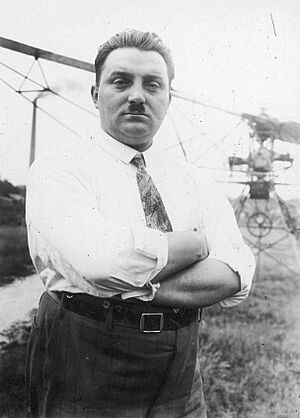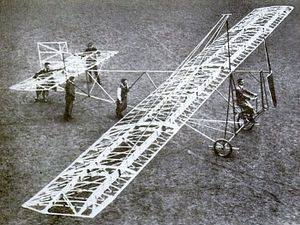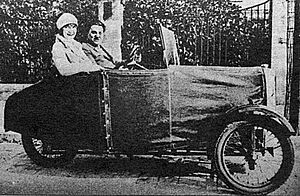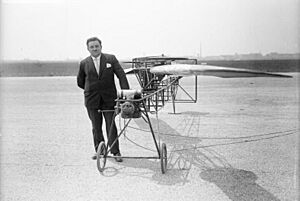Engelbert Zaschka facts for kids
Quick facts for kids
Engelbert Zaschka
|
|
|---|---|

Inventor Engelbert Zaschka with his first helicopter model "Z I", Berlin 1927
|
|
| Born | September 1, 1895 |
| Died | June 26, 1955 (aged 59) |
| Resting place | Freiburg im Breisgau |
| Nationality | German |
| Occupation | Engineer, Inventor |
| Known for | Helicopter, human-powered aircraft, automobile engineering |
| Title | Chief Engineer, Chief Designer, Inventor |
| Signature | |
Engelbert Zaschka (born September 1, 1895, died June 26, 1955) was a clever German engineer and inventor. He was born and passed away in Freiburg im Breisgau, Germany.
Zaschka was one of the first people in Germany to work on helicopters. He also helped create planes that could fly using only human power. Plus, he invented a car that could fold up! Engelbert Zaschka spent most of his time thinking about aviation (flying) and cars.
He was a key person in developing "rotary aircraft," which are flying machines with spinning parts. In 1928 and 1929, Zaschka designed the first small car that could collapse and fold. Later, in 1934, he built an early airplane powered by a person.
Contents
Life of Engelbert Zaschka
Engelbert Zaschka grew up in a family of musicians. His father taught music and played in the city orchestra. His mother was a singer. Engelbert was the second of four children.
When he was just 14, he applied for his first patent. He even started a "hobby flying club" and tried flying near the Schlossberg in Freiburg. After school, he studied engineering in Altenburg.
He then worked as an engineer in Düsseldorf. In 1916, he moved to Berlin. There, he became the chief designer for a company called Orion Aktiengesellschaft für Motorfahrzeuge. In the 1930s and 1940s, Zaschka worked for the aircraft maker Henschel. After World War II, he returned to Freiburg. He opened a workshop there, making things like bicycles. Zaschka passed away in his hometown in 1955.
He became known as one of Germany's first helicopter pioneers. His "rotating airplane" was very special. In 1929, Zaschka also worked on a "folding three-wheeler" car in Berlin. This city car was designed to be cheap and save space because it could be folded up after use. In 1934, he finished building a large human-powered aircraft. Zaschka was an inventor who held many international patents for his helicopter ideas.
Zaschka's Amazing Inventions
The Zaschka Helicopter
In 1927, Engelbert Zaschka built a helicopter in Berlin. It had two rotors (the spinning blades). It also used a gyroscope to make it more stable. This gyroscope helped store energy for a smooth, controlled landing. Zaschka wanted to create a very good propeller system.
A propeller at the back could swivel to help the helicopter move forward and steer. His machine was a mix of an autogyro and a helicopter. Zaschka said the best part of his helicopter was that it could stay still in the air. It could also land straight down, even on the roof of a big building. The helicopter looked a bit like a regular monoplane (a plane with one main wing). But its wings spun around the body of the aircraft.
Zaschka's Human-Powered Aircraft (1934)
In 1934, Engelbert Zaschka finished building a large human-powered aircraft. He called it the Zaschka Human-Power Aircraft. This plane had a long, narrow wing that stretched about 66 feet (20 meters).
On July 11, 1934, Zaschka actually flew this plane. He flew it about 20 meters at Berlin's Tempelhof Airport. He did this without any help from an engine or a launch system. He used only his own muscle power!
The German Orionette Motorcycle (1921-1925)
From 1921 to 1925, Engelbert Zaschka led the design team at Orionette AG für Motorfahrzeuge in Berlin. During this time, they created some very interesting and unusual motorcycle designs. Orionette was a well-known German motorcycle brand from that period.
The Folding Zaschka Three-Wheeler (1929)
Even in the 1920s, people were thinking about crowded cities and parking problems. In 1929, Engelbert Zaschka invented a three-wheeled car in Berlin. Zaschka's car was special because it could fold up. You could take it apart into three main sections in just 20 minutes!
The car could travel at speeds of 25 to 30 miles per hour. Some ideas from Zaschka's car were important to the American inventor Richard Buckminster Fuller. Fuller used these ideas when he developed his Dymaxion car in 1933.
Zaschka as a Composer
Engelbert Zaschka also created popular music. One of his songs was Slavoma - Der neuste Tanz (1925). This song was recorded by at least two different orchestras. He also wrote and composed the funny song Wer hat denn bloß den Hering am Schlips mir festgemacht (which means, "Who just fastened the herring to my tie?") in 1928.
Patents by Zaschka
A patent is a special right given to an inventor. It means no one else can make, use, or sell their invention for a certain time without permission. Engelbert Zaschka held many patents for his inventions, especially for his helicopters.
- , DE 573961 „Hubschraubenflugzeug“ (Helicopter Aircraft) issued June 19, 1926
- , GB 272962 „Improvements in or relating to Helicopter Flying Machines“ issued June 20, 1927
- , US 1779524 „Helicopter“ issued June 29, 1927
- , DE 512513 „Triebwerk fuer Maschinen mit hin und her gehenden Kolben, deren Pleuelstangen durch auf der Triebwelle sitzende Exzenterscheiben betaetigt werden“ (Engine for machines with reciprocating pistons, whose connecting rods are actuated by eccentric discs on the drive shaft) issued November 12, 1927
- , US 1944052 „Portable power plant.“ issued April 21, 1930
- , FR 1019111 „Bicyclette.“ (Bicycle) issued May 26, 1950
Zaschka's Book
- Zaschka, Engelbert. Drehflügelflugzeuge. Trag- und Hubschrauber. Berlin-Charlottenburg: C.J.E. Volckmann Nachf. E. Wette. 1936. ASIN B001PE5XZ2.
This book is one of the first ever published about helicopters. Zaschka wrote it in 1936. It was for airplane designers and anyone interested in building rotary-wing aircraft.
Images for kids
TV Documentary
Engelbert Zaschka's work was featured in a TV show called Große Ideen – kleine Flops: Geistesblitze von A bis Z. This documentary was made in Germany in 2016. It explored big ideas, some of which worked and some that didn't. You can find more information about the documentary here.
See also
- List of rotorcraft
- Human-powered aircraft
- Three-wheeled car












